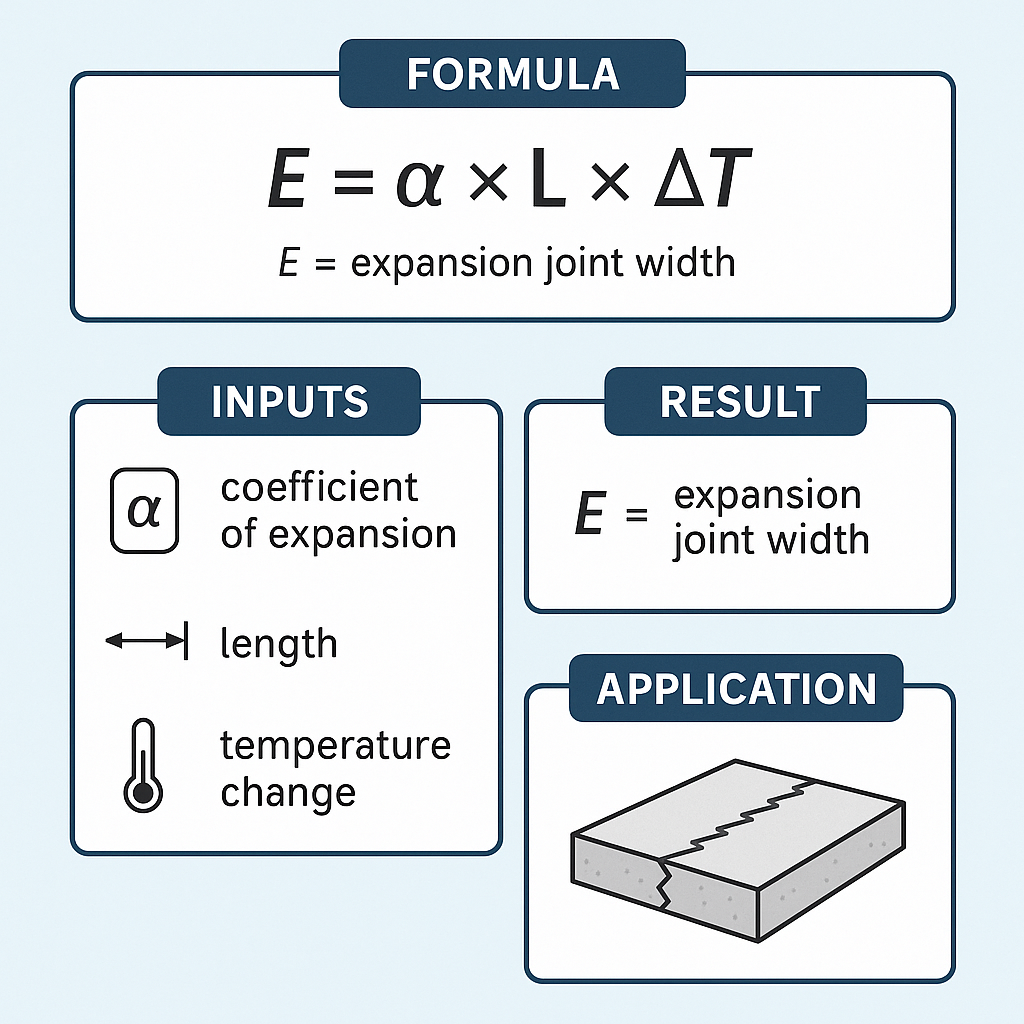Free Expansion Joint Calculator Online
Expansion joints are critical in construction to allow building materials to expand and contract with temperature changes, moisture variations, and structural movements. The Expansion Joint Calculator from Construction Calculators is a vital tool that helps engineers, architects, and contractors determine the correct spacing, width, and placement of joints in concrete slabs, walls, bridges, and roadways. By using accurate measurements and data-driven formulas, this tool supports durable design, minimizes cracking, and extends the life of structural elements.
What Is an Expansion Joint Calculator?
An Expansion Joint Calculator is a tool designed to estimate the appropriate distance between joints, the joint width, and the type of joint material required for various structures. It takes into account factors like material type, length of the concrete element, temperature variation, and expected expansion or contraction rates. The calculator helps ensure that expansion joints effectively accommodate dimensional changes, preventing structural stress or damage over time.

Importance of Expansion Joints in Construction
Expansion joints are essential because construction materials naturally expand and contract due to environmental changes. Without proper spacing and design, this movement can lead to cracks, buckling, or separation of structural components. By incorporating calculated expansion joints, buildings and infrastructure can better withstand thermal shifts, seismic activity, settlement, and load cycles. This improves overall safety, structural longevity, and user comfort.
Inputs Required for Expansion Joint Calculation
To use an expansion joint calculator effectively, the following parameters are typically needed:
- Length of the concrete element (in feet or meters)
- Material coefficient of thermal expansion
- Temperature differential (maximum and minimum expected temperatures)
- Permissible movement
- Width of the slab or structure
- Environmental exposure and loading conditions
These values help determine how much movement a structure will undergo and what spacing and material properties are needed in the expansion joints.
Expansion Joint Calculation Formula
The general formula used for calculating expansion joint spacing is: Where:
- = Length of the concrete slab or structure
- = Coefficient of thermal expansion (per °C or °F)
- = Temperature range (maximum – minimum)
To determine spacing between joints: This ensures each segment has room to expand without causing internal stress.
Example Calculation
Assume a concrete sidewalk is 100 feet long with a thermal expansion coefficient of 10 × 10^-6 per °F, and the temperature varies from 30°F to 100°F (a difference of 70°F): If the allowable movement per joint is 0.25 inches, the number of joints required: This example helps ensure sufficient spacing and movement control across the slab.
Types of Expansion Joints
There are several types of expansion joints, each serving specific structural needs:
- Open joints: Simple gaps filled with flexible material
- Compression seal joints: Preformed seals that compress and expand
- Sliding plate joints: Used in bridges and large structural elements
- Asphaltic plug joints: Common in roadways for water resistance and flexibility
- Modular expansion joints: For accommodating large movements in bridges and viaducts
Each type is selected based on movement range, loading, durability, and exposure.
Key Factors Affecting Expansion Joint Design
Several variables influence the spacing and type of expansion joint required:
- Material behavior: Different materials (steel, concrete, asphalt) expand at different rates
- Structure length and orientation: Longer spans require more joints
- Environmental exposure: Sunlight, moisture, and temperature cycles impact movement
- Load conditions: Traffic, vibration, seismic activity, and usage patterns all matter
- Joint filler type: Must accommodate movement and protect from moisture
Understanding these factors ensures the correct joint design and placement.
Benefits of Using an Expansion Joint Calculator
- Accuracy: Reduces guesswork in joint spacing and sizing
- Efficiency: Streamlines planning and specification stages
- Cost-effective: Avoids overuse or underuse of materials
- Longevity: Prevents early structural damage and reduces repair needs
- Code compliance: Meets standards in ACI, ASTM, Eurocode, and other guidelines
Using a calculator ensures reliable project planning and execution.
Recommended Expansion Joint Spacing Guidelines
While each project may vary, typical recommendations include:
- Concrete slabs: Joints every 20 to 30 feet
- Road pavements: 40 to 60 feet depending on design and climate
- Sidewalks: Every 5 to 10 feet
- Bridges: As per dynamic movement and modular joint system specs
These guidelines should always be cross-checked with engineering standards and adjusted for specific use cases.
Software and Tools Supporting Expansion Joint Design
- Finite Element Analysis (FEA): For modeling joint behavior under stress
- CAD/BIM software: To visualize joint layout in building models
- Construction calculators: For combining expansion with load, slab thickness, and material properties
These tools complement the calculator by improving design visualization and integration.
Common Mistakes to Avoid
- Ignoring joint spacing: Leads to cracking and structural damage
- Underestimating temperature range: Results in undersized joints
- Using improper joint fillers: Causes seal failure and water ingress
- Neglecting slab movement from shrinkage: Adds to expansion issues
- Poor placement and alignment: Reduces joint effectiveness and aesthetics
Avoiding these mistakes ensures better performance and durability.
Expansion Joint Materials and Specifications
Popular expansion joint materials include:
- Rubber and neoprene: Flexible and durable
- Bitumen-based sealants: Water-resistant and cost-effective
- Metal plates: For structural joints with heavy loading
- PVC/NBR compounds: Chemical-resistant options for industrial use
Always select material based on movement type, load, temperature, and chemical exposure.
Conclusion
An Expansion Joint Calculator is a valuable tool for structural planning in all types of construction projects. From roads and sidewalks to buildings and bridges, accounting for movement due to environmental and structural forces is essential for long-term durability. By accurately inputting material behavior, temperature range, and structural dimensions, engineers and builders can confidently place and size expansion joints that meet both performance standards and regulatory requirements. Available on the Concrete Calculators platform, this tool works seamlessly alongside other resources like the Concrete Block Fill Calculator and Slab Thickness Calculator to support smarter planning and longer-lasting infrastructure.
